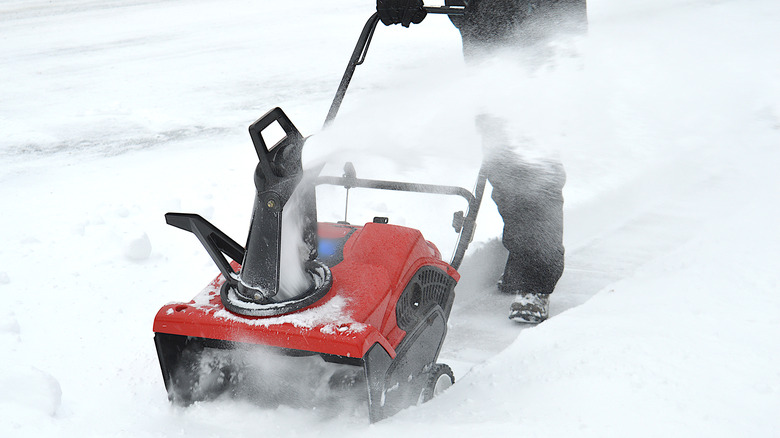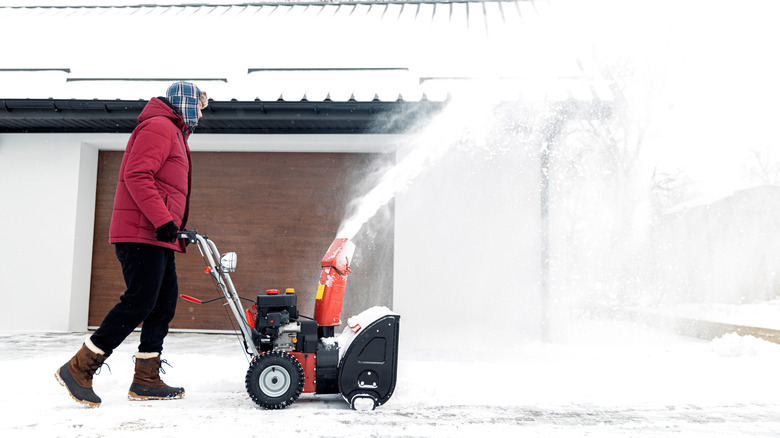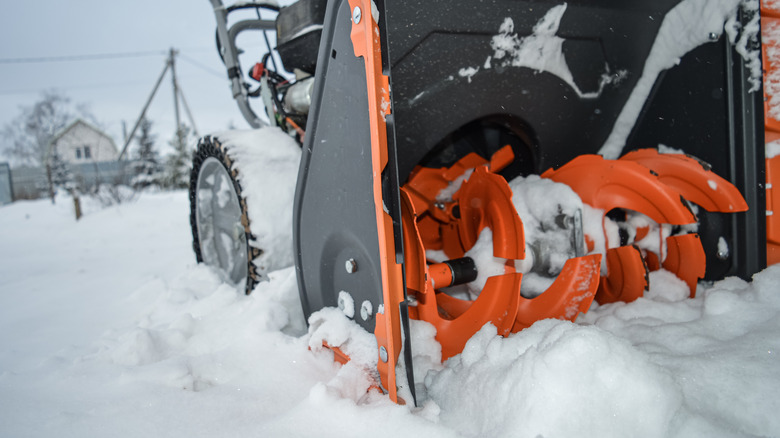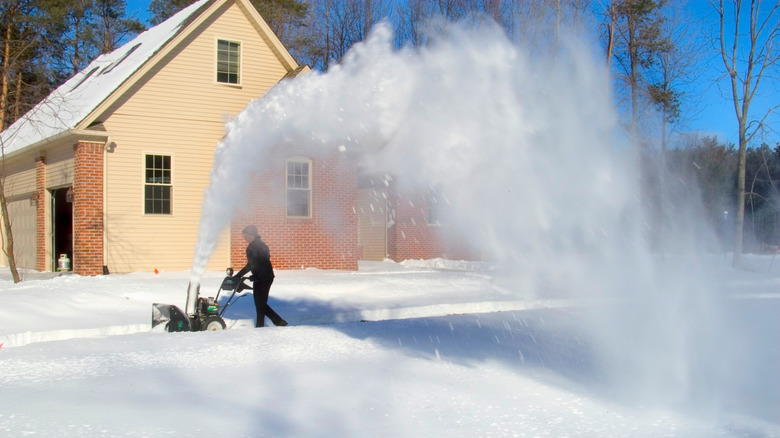Snow Blower Tips For Beginners
We may receive a commission on purchases made from links.
Do you feel overwhelmed by the amount of snow on your driveway during frigid winter months? Upwards of 25% of the contiguous United States was covered by snow in November 2024 according to the National Centers for Environmental Information, and in some areas that snowfall can pack especially deep. If you need some help clearing the paths ahead, it might finally be time to set your shovel aside and invest in new winter tools. Namely, it might be time to nab a snow blower.
Shoveling snow is a tried-and-true method that will always be important, especially in the event of a power outage, but it comes with some inherent dangers. Spending long stretches in the cold doing sweaty, physical labor increases your odds of getting frostbite, and if you aren't careful it's easy to slip on hidden ice, or try to lift so much snow at once that you hurt your back, shoulders, or even risk triggering a heart attack. A snow blower minimizes these risks by clearing snow faster and with less physical exertion, but newcomers will still need tips to pick the right tool for their situation, operate it safely, and tackle the snowfall when it's easiest to clear.
Pick the right machine for the job — snow blowers or throwers?
One of the first things to consider when picking out snow-clearing winter tools is whether you want a snow blower or thrower. Colloquially speaking these terms have been used interchangeably, but there is technically a difference. Snow blowers work in two or three stages, scooping up snow into auger drills so it can be broken up before an impeller rotor shoots the snow away. Meanwhile, snow throwers are essentially smaller blowers that scoop and toss snow aside in one movement.
As with many items on the market, the key difference to consider is cost versus power. If you only have light snowfall or one sidewalk to clear, a cheaper snow thrower like this Litheli battery-powered option is probably good enough — best for situations with 12 inches of snow or less, particularly on level surfaces. (Not to mention how the lightweight machinery is easier to store and maintain.) Meanwhile, two-stage snow blowers and up will have wider and taller intake scoops that collect more, deeper snow, with their drills being better for breaking up ice. These are ideal for roads or larger, inclined spaces, and a three-stage blower can tackle up to 23 inches.
Another important point is whether you want a gas-powered or electric winter tool. Gas options like the PowerSmart gas snow blower tend to be stronger, able to self-propel without as many movement restrictions. Meanwhile, electric snow blowers could be corded or battery-powered, but overall tend to be lighter, less work to maintain, and cheaper — especially for long-term costs like fuel. Either way, you'll need a different solution to remove snow from your balcony.
Tips to operate your snow blower safely
Once you've picked out the right type of snow blower (or thrower) for your home, the next step is to learn safety tips before taking it out on your driveway. Shoveling can be dangerous even when following a proper homeowner's guide to snow shovels, but blowers have more moving parts. Children under 15 and pets should be kept away while you're operating a snow blower, regardless of whether they want to play in the snow. Also be sure not to leave your snow blower unattended, especially in an enclosed area (where gas-powered blowers will be spewing carbon monoxide), and don't point its output in the direction of another person or property; remember that more powerful models can toss snow upwards of 50 feet. Make sure the area is similarly clear of loose items like doormats, and don't run over your own cord if you're using an electric tool.
As far as personal safety tips are concerned, many tenets of operating heavy machinery also apply here: don't touch any moving parts, don't wear loose clothes or scarves that might get caught, use ear plugs to protect your hearing (especially from a gas-powered blower) and always assume the engine is running until you've given your snow blower ample time to shut down. Also avoid this common mistake when dealing with snowy lawns: if your machine gets clogged, one pro tip is to clear wet snow and debris with a long stick rather than your hands.
Choose the best time to break out your snow blower
While two- and three-stage snow blowers will be more effective at clearing larger snow drifts, as well as less ideal conditions such as icy snow, there are still times when it will be best to start hitting your sidewalk or driveway. One tip: freshly fallen snow will be lighter and easier to handle, less prone to jamming your snow blower than wet or compacted snow which has been sitting outside. In fact, it's recommended to clear your property within 12 hours of the weather stopping, clearing a path at least 36 inches wide and applying road salts wherever necessary, as they lower the freezing point of water and add traction to the ground so people are less likely to slip.
With these tips in mind, hopefully you're ready to start hacking away at the walls of snow stacking outside of your home. Whether or not you're also using high-tech solutions for your snowy front steps like heated floor mats, having a good snow blower on hand will ensure you're ready for anything nature has to throw at you.



